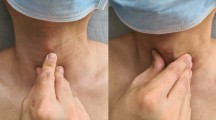Abstract
Temporary dysphagia after anterior cervical discectomy (ACD) is common. However, its mechanism is poorly understood. Pressure induced by retractor blades onto pharynx/esophagus were measured intraoperatively in order to gain more information regarding traumatization of the pharynx/esophagus wall. Thirty-one patients underwent anterior cervical discectomy and fusion (ACDF) for degenerative disc disease. An online pressure transducer was applied to the rear side of the medial retractor blade (epi-esophageal-pressure, epi-P) and a cylindric, inflatable transducer was preoperatively inserted into the pharynx/esophagus under fluoroscopic guidance at the level to be operated on (endo-esophageal-pressure, endo-P). Pressure values were recorded continuously during the operation. Mean arterial pressure (MAP) and endotracheal cuff pressure (ETCP) were recorded additionally. An in vitro model was developed in order to analyze the impact of the retractor blade design onto the epi-esophageal-pressure. Mean epi-P before and following adequate retractor opening for exposure of the disc space was 58.3 and 92.7 mmHg. Thirty, 60 and 90 min later the epi-P decreased to 79, 70 and 66%, respectively. Mean basal endo-P was 9.8 mmHg and increased to 20.6 mmHg after retractor placement. Thirty, 60 and 90 min later the endo-P decreased to 80, 71 and 62%, respectively. The mean MAP was 76 mmHg and the ECTP was adjusted to 25 mmHg during the procedures. In the in vitro model retraction pressure correlated inversely with the contact area between visceral wall and retractor blade. During ACDF the retraction pressure onto the pharyngeal/esophageal wall exceeds MAP and even more the mucosal perfusion pressure of 25 mmHg. Over time the pharynx/esophageal wall adapts to the applied pressure induced by the retractor blade. The contact area between them influences the retraction pressure.




Similar content being viewed by others
References
Bazaz M, Lee M, Yoo JU (2002) Incidence of dysphagia after anterior cervical spine surgery: a prospective study. Spine 27:2453–2458
Bose B (1998) Anterior cervical fusion using Caspar plating: analysis of results and review of the literature. Surg Neurol 49:25–31
Brimacombe J, Keller C, Puehringer F (1999) Pharyngeal mucosal pressure and perfusion: a fiberoptic evaluation of the posterior pharynx in anaesthetized adult patients with a modified cuffed oropharyngeal airway. Anaesthesiology 91:1661–1665
Edwards CC, Karpitskaya Y, Cha C, Heller JG, Lauryssen C, Yoon ST, Riew KD (2004) Accurate identification of adverse outcomes after cervical spine surgery. J Bone Joint Surg 86:251–256
Lee SK, Lee GY, Wong GT (2004) Prolonged and severe dysphagia following anterior cervical surgery. J Clin Neurosci 11:424–427
Ratnaraj J, Todorov A, McHugh T, Cheng MA, Lauryssen C (2002) Effects of decreasing endotracheal tube cuff pressures during neck retraction for anterior cervical spine surgery. J Neurosurg 97:176–179
Schiebler TH, Schmidt W (1987) Lehrbuch der Anatomie des Menschen. Springer, Berlin Heidelberg New York
Stewart M, Johnston RA, Steward I (1995) Swallowing performance following anterior cervical spine surgery. Br J Neurosurg 9:605–609
Styf JR, Willen J (1998) The effects of external compression by three different retractors on pressure in the erector spine muscles during and after posterior lumbar spine surgery in humans. Spine 23:354–358
Taylor H, McGregor A, Medhi-Zadeh S, Richards S, Kahn N, Zadeh JA, Hughes S (2002) The impact of self-retaining retractors on the paraspinal muscles during posterior spinal surgery. Spine 27:2758–2762
Winslow CP, Winslow TJ, Wax MK (2001) Dysphonia and dysphagia following the anterior approach to the cervical spine. Arch Otolaryngol Head Neck Surg 127:51–57
Author information
Authors and Affiliations
Corresponding author
Additional information
Part II of this article can be found under http://dx.doi.org/10.1007/s00586-006-0070-7
Rights and permissions
About this article
Cite this article
Heese, O., Schröder, F., Westphal, M. et al. Intraoperative measurement of pharynx/esophagus retraction during anterior cervical surgery. Part I: pressure. Eur Spine J 15, 1833–1837 (2006). https://doi.org/10.1007/s00586-006-0069-0
Received:
Revised:
Accepted:
Published:
Issue Date:
DOI: https://doi.org/10.1007/s00586-006-0069-0




